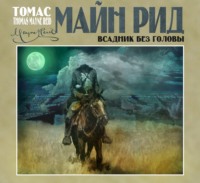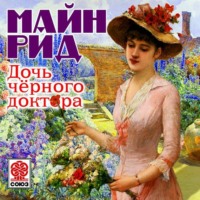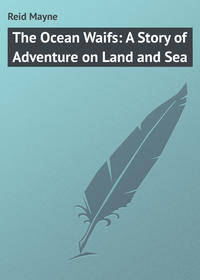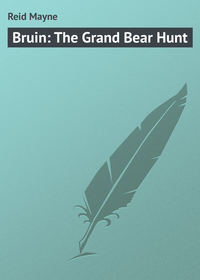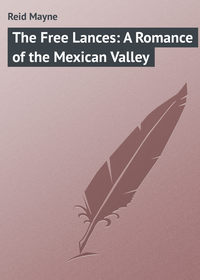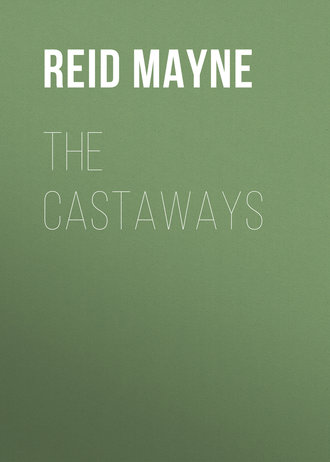 полная версия
полная версияThe Castaways
“Durion!” echoed the captain, pronouncing the word properly, as translated from Saloo’s pigeon English.
“Yes, cappen; foolee me no think of him befole. Belly big danger. It fallee on skull, skull go clashee clashee.”
This was evident without Saloo’s explanation. The lacerated arm and broken shell were evidences enough of the terrible effects that would have been produced had the grand pericarp in its downward descent fallen upon the heads of either of the children, and they all saw what a narrow escape Henry had of getting his “cocoa-nut” crushed or split open.
Chapter Eight.
Shooting at Fruit
As soon as the three men had got well up to the ground and ascertained the cause of Helen’s alarm, and the damage done to Henry’s jacket and skin, Murtagh was the first to make a demonstration. He did so by running in under the tree, and stooping to lay hold of the fruit that had caused the misfortune. Saloo saw him do this without giving a word of warning. He was, perhaps, a little piqued that the Irishman should make himself so conspicuous about things he could not possibly be supposed to understand, and which to the Malay himself were matters of an almost special knowledge. There was a twinkle of mischief in his eye as he contemplated the meddling of Murtagh, and waited for the dénouement.
The latter, rashly grasping the spiny fruit, did not get it six inches above the ground, before he let go again, as if it had been the hottest of hot “purtatees.”
“Och, and what have I done now!” he cried, “I’m jagged all over. There isn’t a smooth spot upon it – not so much as a shank to take howlt of!”
“You takee care, Multa,” cautioned Saloo. “You lookee aloff. May be you get jagee in de skull!”
Murtagh took the hint, and, giving one glance upward, ran back with a roar from under the shadow of the tree.
The Malay, seemingly satisfied with his triumph, now glided underneath the durion, and keeping his eye turned upward, as if intently watching something, he struck the fruit with the piece of pointed stick which he had been using in the search after Singapore oysters, and sent it spinning out upon the open sand beach. Then following, he took out his knife, and inserting the blade among its thickly set spines, cleft it open, displaying the pulp inside.
There was enough to give each person a taste of this most luscious of fruits, and make them desirous of more; even had they not been hungry. But the appetites of all were now keen, and neither the chase nor the fishery had produced a single thing to satisfy them. All three had returned empty-handed. There were many more nuts on the durion-tree. They could see scores of the prickly pericarps hanging overhead, but so high as to make the obtaining of them apparently impossible. They were as far away as the grapes from the fox of the fable.
The stem of the tree rose over seventy feet before throwing out a single branch. It was smooth, moreover, offering neither knot nor excrescence for a foothold. For all this Saloo could have climbed it, had he been in proper strength and condition. But he was not so. He was still weak from the effects of his suffering at sea.
Something more must be had to eat – whether game, fish or shell-fish.
The one great oyster appeared to be a stray. Saloo had begun to despair of being able to find another. The fruit of the durion proved not only pleasant eating, but exceedingly nutritious. It would sustain them, could they only get enough of it. How was this to be obtained?
For a time they stood considering; when Captain Redwood became impressed with an original idea.
In addition to his own rifle, a large ship’s musket had been put into the pinnace. He thought of chain-shot, and its effects; and it occurred to him that by this means the durions might be brought down from their lofty elevation.
No sooner conceived than carried into execution. The musket was loaded with a brace of balls united by a piece of stout tarred string. A shot was fired into the tree, aimed at a place where the fruit appeared thickest. There was havoc made among the adjacent leaves; and five or six of the great pericarps came crashing to the earth. A repetition of the firing brought down nearly a dozen, enough to furnish the whole party with food for at least another twenty-four hours.
Having collected the fallen pericarps, they carried them to another tree that stood near, amid whose leafy branches appeared to be no fruits either so sweet to the lips or dangerous to the skull.
Thither also they transferred their quarters, along with the paraphernalia brought up from the boat, intending to make a more permanent encampment under the newly chosen tree.
For the time they kindled no fire, as the weather was warm enough, and the durions did not require cooking; and while making their mid-day meal of the raw fruit, Saloo interested them by relating some particulars of the tree from which it had been obtained.
We shall not follow the Malay’s exact words, for, as spoken in “pigeon English,” they would scarce be understood; but shall lay before our readers some account of this strange and valuable fruit-tree, culled partly from Saloo’s description and partly from other sources.
The durion is a forest tree of the loftiest order, bearing resemblance to the elm, only with a smooth bark, which is also scaly. It is found growing throughout most of the islands of the Indian Archipelago; and, like the mangosteen, does not thrive well in any other part of the world. This is perhaps the reason its fruit is so little known elsewhere, as when ripe it will not bear transportation to a great distance. The fruit is nearly globe-shaped, though a little oval, and in size equals the largest cocoa-nut.
As the reader already knows, it is of a green colour, and covered with short stout spines, very sharp-pointed, whose bases touch each other, and are consequently somewhat hexagonal in shape. With this chevaux-de-frise it is so completely armed, that when the stalk is broken close off it is impossible to take up the fruit without having one’s fingers badly pricked. The outer rind is so tough and strong, that no matter from what height the fruit falls it is never crushed or broken. From the base of the fruit to its apex, five faint lines may be traced running among the spines. These form the divisions of the carpels where the fruit can be cut open with a sharp knife, though requiring a considerable exertion of strength. The five cells found within are of a silken white colour, each filled with an oval-shaped mass of cream-coloured pulp containing several seeds of the size of chestnuts. The pulp forms the edible portion of the fruit, and its consistence and flavour are both difficult to be described. Mr Wallace, the celebrated hunter naturalist, thus quaintly describes it: —
“A rich, butter-like custard, highly flavoured with almonds, gives the best general idea of it; but intermingled with it come wafts of flavour that call to mind cream-cheese, onion-sauce, brown-sherry, and other incongruities. Then there is a rich glutinous smoothness in the pulp, which nothing else possesses, but which adds to its delicacy. It is neither acid, nor sweet, nor juicy; yet one feels the want of none of these qualities, for it is perfect as it is. It produces no nausea, or other bad effects; and the more you eat of it the less you feel inclined to stop. In fact, to eat durions is a new sensation, worth a voyage to the East to experience. When the fruit is ripe it falls of itself; and the only way to eat durions to perfection is to get them as they fall, and the smell is then less overpowering. When unripe, it makes a very good vegetable if cooked, and it is also eaten by the Dyaks raw. In a good fruit season large quantities are preserved salted, in jars and bamboos, and kept the year round, when it acquires a most disgusting odour to Europeans, but the Dyaks appreciate it highly as a relish with their rice. There are in the forest two varieties of wild durions with much smaller fruits, one of them orange-coloured inside. It would not perhaps be correct to say that the durion is the best of all fruits, because it cannot supply the place of a sub-acid juicy kind; such as the orange, grape, mango, and mangosteen, whose refreshing and cooling qualities are so wholesome and grateful; but as producing a food of the most exquisite flavour, it is unsurpassed. If I had to fix on two only as representing the perfection of the two classes, I should certainly choose the durion and the orange as the king and queen of fruits.
“The durion is however sometimes dangerous. When the fruit begins to ripen it falls daily and almost hourly, and accidents not unfrequently happen to persons walking or working under the trees. When the durion strikes a man in its fall it produces a dreadful wound, the strong spines tearing open the flesh, whilst the blow itself is very heavy; but from this very circumstance death rarely ensues, the copious effusion of blood preventing the inflammation which might otherwise take place. A Dyak chief informed me that he had been struck by a durion falling on his head, which he thought would certainly have caused his death, yet he recovered in a very short time.”
Both the natives of the Malayan Archipelago and strangers residing there regard the durion as superior to all other kinds of fruit – in short, the finest in the world. The old traveller, Luischott, writing of it as early as 1599, says that in flavour it surpasses all other fruits. While another old traveller, Doctor Paludanus, thus speaks of it: “This fruit is of a hot and humid nature. To those not used to it, it seems at first to smell like rotten onions, but immediately they have tasted it they prefer it to all other food. The natives give it honourable titles, exalt it, and make verses on it.”5
Chapter Nine.
Gagging a Gavial
After finishing their dinner of durions, the three men again sallied forth, to see whether something more substantial could be found for a later repast – either flesh, fowl, or fish. As before, they went in different directions – Captain Redwood into the forest, Murtagh up the stream, and Saloo along the sea-beach, where he waded out into the water, still in the hope of picking up another large oyster. He took with him a stalk of bamboo, pointed at one end, to be used as a probe in the soft bottom in case any oysters might be lying perdu beneath the sand.
Henry and Helen were again left to themselves, but this time they were not to remain seated under any tree – at least, not all the time. The father, before leaving, had enjoined upon both of them to take a bath; ablution having become very necessary on account of their having been so long cribbed up in the somewhat dirty pinnace. It would be also of service in promoting their restoration to health and strength. They went into the water, not together, but at some distance apart – Henry choosing to go down to the sea, while Helen entered the stream close by, as it had clear water with a smooth, sandy bed; besides, she thought it was safer, being free from surf or currents.
It was only safer in appearance, as the sequel proved; for the hunters and fisherman had scarce scattered off out of hearing, when a cry broke upon the still air of noon that startled the bright-winged birds of the Bornean forest, and stopped their songs as quickly as would have done a shot from Captain Redwood’s rifle. It was heard by the captain himself, strolling among the tree trunks, and looking aloft for game; by Murtagh on the river bank, endeavouring to beguile the sly fish to his baited hook; by Saloo, wading knee-deep in search of Singapore oysters; and by Henry swimming about upon the buoyant incoming tide. More distinctly than all the rest, the little Helen heard it – since it was she who gave it utterance.
It was a cry of distress, and brought all the others together, and running toward the point whence it came. There was no difficulty about their knowing the direction, for one and all recognised Helen’s voice, and knew where she had been left.
In less than sixty seconds’ time they stood together upon the bank of the stream, on the same spot from which they had parted; and there beheld a spectacle that thrilled them with fear, and filled them with horror.
The girl, finding it not deep enough by the edge of the stream – at this point nearly a hundred yards in width – had waded midway across, where it came quite up to her neck; and there she stood, her head alone showing above the surface. Beyond her, and coming from the opposite side, showed another head, so hideous it was no wonder that, on first perceiving it, she had given way to affright, and voice to her terror.
It was the head of an enormous reptile, of lizard shape, that had crawled out from a reedy covert on the opposite side of the river, and having silently let itself down into the water, was now swimming toward the terrified bather. There could be no mistaking the monster’s intent, for it was coming straight toward its victim.
“A gavial!” cried Saloo, as his eyes rested on the body of the huge saurian, full twenty feet in length, with its head over a yard long, and jaws nearly the same, the upper one surmounted by a long knob-like protuberance, that distinguishes it from all other reptiles.
“A gavial!” echoed the others, though not inquiringly; for they knew too well both the shape and character of the creature that was crossing the river.
As all four first reached the bank – arriving nearly at the same instant of time – there were about twenty yards between the hideous saurian and her who seemed destined to destruction. On first perceiving her danger, the girl had made a few plunges to get back to the bank; but, hindered by the depth to which she had unwarily waded, and overcome by terror, she had desisted from the attempt; and now stood neck-deep, giving utterance to cries of despair.
What was to be done? In less than a minute more the jaws of the saurian would close upon her crashing her fair, tender form between its teeth as though she were only some ordinary prey – a fish, or the stem of some succulent water-plant!
Her father stood on the bank a very picture of distress. Of what use the rifle held half-raised in his hands? Its bullet, not bigger than a pea, would strike upon the skull of such a huge creature harmlessly, as a drop of hail or rain. Even could he strike it in the eye – surging through the water as it was, a thing so uncertain – that would not hinder it from the intent so near to accomplishment. The Irishman, with only fish-hooks in his hand, felt equally impotent; and what could the boy Henry do, not only unarmed but undressed – in short, just as he had been bathing —in puris naturalibus!
All three were willing to rush into the water, and getting between the reptile and its victim, confront the fierce creature, even to their own certain sacrifice.
And this, one, or other, or all of them, would have done, had they not been prevented by Saloo. With a loud shout the Malay, hitherto apparently impassive, called upon them to hold back. They obeyed, seeing that he intended to act, and had already taken his measures for rescuing the girl. They could not tell what these were, and only guessed at them by what they saw in his hands. It was nothing that could be called a weapon – only a piece of bamboo, pointed at one end, which he had taken from among the embers of last night’s fire and sharpened with his knife, when he went off in search of the Singapore oysters. It was the same stick he had been using to probe for them under the sand. On seeing the gavial as it started toward the girl, he had quickly drawn out his knife, and sharpened the other end of the stake while coming across the beach.
With this sorry apology for a weapon, and while they were still wondering, he dashed into the stream; and almost before any of the others had recovered from their first surprise, they saw him plunge past the spot where stood the affrighted girl. In another instant his black head, with the long dark hair trailing behind it, appeared in close juxtaposition to the opened jaws of the reptile. Then the head was seen suddenly to duck beneath the surface, while at the same time a brown-skinned arm and hand rose above it with a pointed stake in its grasp – like the emblematic representation seen upon some ancient crest. Then was seen an adroit turning of the stick, so quick as to be scarce perceptible – immediately followed by a backward spring upon the part of the lizard, with a series of writhings and contortions, in which both its body and tail took part, till the water around it was lashed into foam.
In the midst of this commotion, the head of the Malay once more appeared above the surface, close to that of the girl; who, under the guidance of her strangely-skilled and truly courageous rescuer, was conducted to the bank, and delivered safe into her father’s arms; stretched open to embrace her.
It was some time, however, before the stream recovered its wonted tranquillity. For nearly half an hour the struggles of the great saurian continued, its tail lashing the water into foam, as through its gagged jaws a stream rushed constantly down its throat, causing suffocation. But, in spite of its amphibious nature, drowning was inevitable; and soon after became an accomplished fact – the huge reptilian carcass drifting down stream, towards the all-absorbing ocean, to become food for sharks, or some other marine monster more hideous and ravenous than itself.
If, indeed, a more hideous and ravenous monster is to be found! It is sometimes called the Gangetic crocodile, but it is even uglier than either crocodile or alligator, and differs from both in several important particulars.
As, for instance, in its mouth – its jaws being curiously straight, long, and narrow; and in the shape of its head, which has straight perpendicular sides, and a quadrilateral upper surface. It has double, or nearly double, the number6 of the teeth of the crocodile of the Nile, though the latter is well enough supplied with these potent implements of destruction!
It is an amphibious animal, and fond of the water, in which its webbed hind feet enable it to move with considerable celerity.
The huge reptile which threatened Helen’s safety was twenty feet in length, but the gavial sometimes attains the extraordinary dimensions of eight to nine yards.
Sincere was the gratitude of Captain Redwood for the address and courage displayed by the Malay in rescuing his daughter, and his regret was great that he had no means of rewarding his faithful follower.
Chapter Ten.
Burrowing Birds
The fruit diet, however delicious, was not strengthening. Saloo said so, and Murtagh agreed with him. The Irishman declared he would rather have a meal of plain “purtatees and buttermilk,” though a bit of bacon, or even ship’s “junk,” would be more desirable.
All agreed that a morsel of meat – whether salted or fresh – would be highly beneficial; indeed, almost necessary to the complete restoration of their strength.
How was animal food to be procured? The forest, so far as Captain Redwood had explored it, seemed altogether untenanted by living creature. He had now been tramping for upwards of an hour among the trees without seeing either bird or quadruped. And although there were fish in the stream, and should have been shell-fish along the sea-beach, neither Murtagh nor Saloo had succeeded in procuring any. A keen craving for animal food had grown upon them, and they were not without some regretful thoughts at having permitted the dead gavial to drift out to sea. Even from the carcass of the saurian they might have obtained steaks that, if not very dainty or delicate, would at least have been eatable.
Discouraged by their want of success, and still feeling feeble, they did not go out again that day, but remained resting under the tree.
While they were munching their evening meal – of durions, as the dinner had been – the Malay commenced discoursing upon eggs, which set them all thinking about them. If they only had a few, it would be just the very thing to nourish and give them strength. But where were the eggs to be obtained? This was the question asked him by the Irishman, who could at that moment have eaten a dozen, boiled, fried, poached, in omelette, or even, as he said himself, have “sucked” them.
“Iggs indade!” he exclaimed, as Saloo made mention of the article; “I’d loike to see one, an could ate a basketful of them, if they were as big as swans’. What puts iggs in your head, nigger?”
“Eggs no long way off,” rejoined the Malay. “Plenty egg if we knowee whale find ’em.”
“How do you know that? Ye’re ravin’, Saloo.”
“No lavin, Multa. You heal lass night the malee? All night longee he cly wail.”
“Hear the malee. What’s that?”
“Biggee fowl like tulkey. Saloo heal him. Make moan likee man go die.”
“Och, thair was that, thrue enough. I heerd something scramin’ all the night. I thought it might be a banshee, if thair is that crayther in this counthry. A bird, you say? What of that? Its squalling won’t give us any iggs, nor lade to its nest nayther.”
“Ness not belly fal way. Malee make ness in sand close to sea-shole. Mollow mornin’ I go lookee, maybe findee.”
All throughout the previous night they had heard a voice resounding along the shore in loud, plaintive wailings, and Captain Redwood had remarked its being a strange note to him, never having heard the like before. He believed the cries to come from some species of sea-fowl that frequented the coast, but did not think of the probability of their nests being close at hand. As day broke he had looked out for them in hopes of getting a shot. Even had they been gulls, he would have been glad of one or two for breakfast. But there were no birds in sight, not even gulls.
Saloo now told them that the screams heard during the night did not come from sea-fowl, but from birds of a very different kind, that had their home in the forest, and only came to the sea-coast during their season of breeding; that their presence was for this purpose, and therefore denoted the proximity of their nests.
While they were yet speaking on the subject, their eyes were suddenly attracted to a number of the very birds about which they were in converse. There was quite a flock of them – nearly fifty in all. They were not roosted upon the trees, nor flying through the air, but stepping along the sandy beach with a sedate yet stately tread, just like barn-door fowl on their march toward a field of freshly-sown grain, here and there stooping to pick up some stray seed. They were about the size of Cochin-Chinas, and from their flecked plumage of glossy black and rose-tinted white colour, as well as from having a combed or helmeted head, and carrying their tails upright, they bore a very striking resemblance to a flock of common hens.
They, in fact, belonged to an order of birds closely allied to the gallinaceous tribe, and representing it on the continent of Australia as also in several of the Austro-Malayan islands, where the true gallinaceae do not exist. There are several distinct species of them; some, as the tallegalla or “brush turkey” of Australia, approaching in form and general appearance to the turkey, while others resemble the common fowl, and still others might be regarded as a species of pheasant. They have the singular habit of depositing their eggs in mounds of rubbish, which they scrape together for this purpose, and then leave them to what might appear a sort of spontaneous incubation. Hence they are usually called “mound-builders,” though they do not all adhere to the habit; some of them choosing a very different though somewhat analogous mode of getting their eggs hatched. Naturalists have given them the name of megapoda, on account of their very large feet, which, provided with long curved claws, enable them to scratch the ground deeply and rake together the rubbish into heaps for the safe deposit of their eggs.
Sometimes these megapodes, as the Australians call them, for they are as common in Australia as Borneo, raise heaps of fifteen feet in height, and not less than sixty feet in circumference at the base.
They are large and heavy birds, unwieldy in their motions, slow and lumbering in their flight. Their legs are thick, and their toes are also thick and long.
There is some difference between their nest-building ways and those of the tallegalla; yet, on the whole, the similarity is very striking, as may be seen from the following account.



